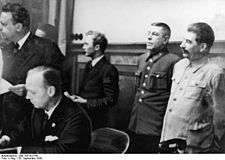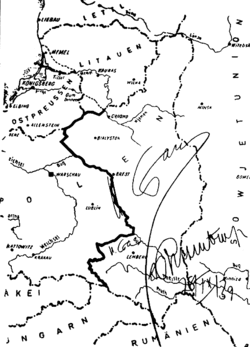German–Soviet Frontier Treaty
| Hitler-Stalin Pact | |
|---|---|
|
Soviet Foreign Minister Vyacheslav Molotov signs the German–Soviet Pact in Moscow, September 28, 1939; behind him are Richard Schulze-Kossens (Ribbentrop's adjutant), Boris Shaposhnikov (Red Army Chief of Staff), Joachim von Ribbentrop, Joseph Stalin, Vladimir Pavlov (Soviet translator). Alexey Shkvarzev (Soviet ambassador in Berlin), stands next to Molotov | |
|
Map attached to the German–Soviet Treaty dividing Poland into German and Soviet occupation zones |
The German-Soviet Frontier Treaty was a second supplementary protocol,[1] of the 1939 Hitler-Stalin Pact (known as the German-Soviet Treaty of Nonaggression, or by its original name of the German–Soviet Treaty of Friendship, Cooperation and Demarcation).[2] It was a secret clause as amended on September 28, 1939 by Nazi Germany and the Soviet Union after their joint invasion and occupation of sovereign Poland.[3] It was signed by Joachim von Ribbentrop and Vyacheslav Molotov, the foreign ministers of Germany and the Soviet Union respectively, in the presence of Joseph Stalin. The treaty was a follow-up to the first secret protocol of the Molotov–Ribbentrop Pact signed on August 23, 1939 between the two countries prior to their invasion of Poland and the start of World War II in Europe. Only a small portion of the protocol which superseded the first treaty was publicly announced while the spheres of influence of Nazi Germany and the Soviet Union remained classified. The third secret protocol of the Pact was signed on January 10, 1941 by Friedrich Werner von Schulenberg, and Molotov, whereas Germany renounced its claims to portions of Lithuania, only a few months before their anti-Soviet Operation Barbarossa.[4]
Secret articles

Several secret articles were attached to the treaty. These articles allowed for the exchange of Soviet and German nationals between the two occupied zones of Poland, redrew parts of the central European spheres of interest dictated by the Molotov–Ribbentrop Pact, and also stated that neither party to the treaty would allow on its territory any "Polish agitation" directed at the other party.
During the western invasion of Poland, the German Wehrmacht had taken control of the Lublin Voivodeship and eastern Warsaw Voivodeship - territories which according to the Molotov–Ribbentrop Pact were in the Soviet sphere of influence. To compensate the Soviet Union for this "loss", the treaty's secret attachment transferred Lithuania to the Soviet sphere of influence, with the exception of a small territory in the Suwałki Region, sometimes known as the Suwałki Triangle. After this transfer, the Soviet Union issued an ultimatum to Lithuania, occupied it on June 15, 1940 and established the Lithuanian SSR.
References
- ↑ Sharon Korman (1996). The Right of Conquest : The Acquisition of Territory by Force in International Law and Practice. Oxford University Press. p. 167. ISBN 0191583804. Retrieved 25 April 2015.
For the text of the German-Soviet Frontier Treaty see Degras, Soviet Documents on Foreign Policy, iii. 377.
- ↑ Davies 2008, page 30 (ibidem).
- ↑ Davies, Norman (2008) [1996]. Europe: a History. Oxford University Press, Pan Macmillan. pp. 1001, 1004. ISBN 0-19-820171-0.
- ↑ Britannica (2015). "A secret supplementary protocol (signed September 28, 1939)". German-Soviet Nonaggression Pact. Encyclopædia Britannica. Retrieved 25 April 2015.
- Eidintas, Alfonsas; Vytautas Žalys; Alfred Erich Senn (September 1999). Ed. Edvardas Tuskenis, ed. Lithuania in European Politics: The Years of the First Republic, 1918–1940 (Paperback ed.). New York: St. Martin's Press. p. 170. ISBN 0-312-22458-3.
External links
- Text of the treaty (English translation) from ElectronicMuseum online, Polish-Canadian website commemorating Katyn massacre
![]() Media related to German–Soviet Boundary and Friendship Treaty at Wikimedia Commons
Media related to German–Soviet Boundary and Friendship Treaty at Wikimedia Commons
![]() Works related to German-Soviet Boundary and Friendship Treaty 28 September 1939 at Wikisource
Works related to German-Soviet Boundary and Friendship Treaty 28 September 1939 at Wikisource

